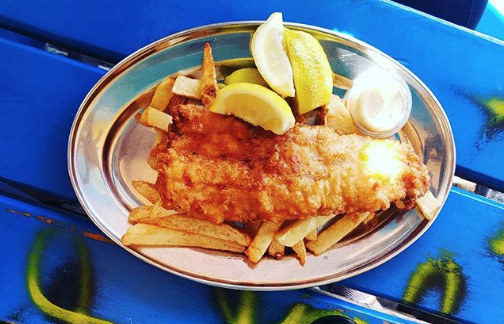If you could eat Cape Town, this is what it would taste like. These dishes are the quintessential flavour of the Cape – sweet, salty, spicy, delicious. The kinds of foods that make you lick your fingers and instantly remember the best times of your life. The kinds of smells that transport you back to your mother’s kitchen, or a trip to the seaside, or a two rand treat from the tuck shop. The foods we’ve chosen have a special relationship with the Cape. Some are only found and enjoyed here, and some are representative of the unique cultures that influence Cape Town’s cuisine, from Cape Malay kitchens to the Afrikaans tuis kombuise. Warning: reading this article will make you hungry…
Fish and chips
It’s the perfect Cape coast meal: deep-fried hake wrapped in newspaper, and a bag of slap chips with a dash of vinegar. Crispy, salty, oily goodness. Best enjoyed with a squirt of tomato sauce, a view of the ocean and a free hand for swatting away thieving seagulls. Sure, you could get a grilled hake with a side salad for half the calories and double the price, but there’s nothing like the nostalgic joy of queuing for vis en tjips at a sea-salt-crusted old takeout joint that has stood the test of time. We recommend Fish on the Rocks or Snoekies in Hout Bay, and Kalkies in Kalk Bay.
Masala steak gatsby
This meal is the ultimate indulgence to share with friends. If you’ve tasted one, you’ll salivate at the thought of lifting your chunk of the Gatsby out of the wrapping and sinking your teeth into the juicy, spicy goodness, as the overstuffed fillings fall out and sauce drips down your fingers. Masala steak or chicken are the Rolls Royces of Gatsbys. The undisputed best place to get a Gatsby is
The Golden Dish in Gatesville.
Bobotie
This dish is not a snack or a finger food situation. It is rich, hearty and won’t go down without making you think of your mother at least once. Bobotie shares its origins between Dutch settlers and early Malay residents of the Cape. It has a flavour profile that is quintessential to Cape Malay cooking, blending sweet and spicy elements with ingredients that are typically savoury, like meat and eggs. A bak of bobotie is also at home in any Afrikaans kitchen, and the earliest records of a recipe were in a Dutch cookbook in the early 1600s. Bobotie is usually made with minced beef or lamb meat, although it adapts well to soy or lentils too. Best served with yellow rice and a dollop of Mrs Ball’s chutney. Try out
Bo Kaap Kombuis or Biesmiellah.
Koesisters
Koesisters are a teatime favourite made by Cape Malay cooks and are particular to Cape Town – not to be confused with their plaited counterpart, the koeksuster, which is enjoyed all over South Africa. This sweet, sticky treat is a deep-fried ball of dough that is then soaked in sugar syrup and sprinkled with desiccated coconut. It’s basically a doughnut but much tastier, with flavourants like aniseed, cinnamon, cardamom, ginger and naartjie zest mixed into the dough.
Salomie
Depending on which language you speak, this magnificent culinary creation is also known as a roti, rooti, or curry wrap. This dish combines two already delicious things – a curry, and a flaky, buttery roti – and combines them into a meal you can pick up and eat with your hands (and many, many serviettes). Simply add a tasty curry to a thick, warm roti, roll it up, unhinge your jaw like an alligator to fit it in, chomp, and let the flavours blow your mind. If you’re in search of the ultimate salomie, check out Mariam’s Kitchen in the City Centre or District 6 Cafe in Kuils River.
Pickled fish
Once a year just before Easter time, families all over the Cape prepare jars full of firm white fish such as yellowtail, hake, snoek or kingklip bathed in a mixture of vinegar, sugar, onion, herbs and spices. This preparation method has been around since the Cape colony was founded. Back before refrigerators existed, using vinegar as a preservative would allow people to prepare and store fish for longer without it going bad. Now, pickled fish is the taste of Easter in the Cape, right alongside hot cross buns. In fact, it’s a tradition in many families to eat the fish ON a hot cross bun.
Picture: Instagram






